Cultural Analysis, Volume 21.1, 2023
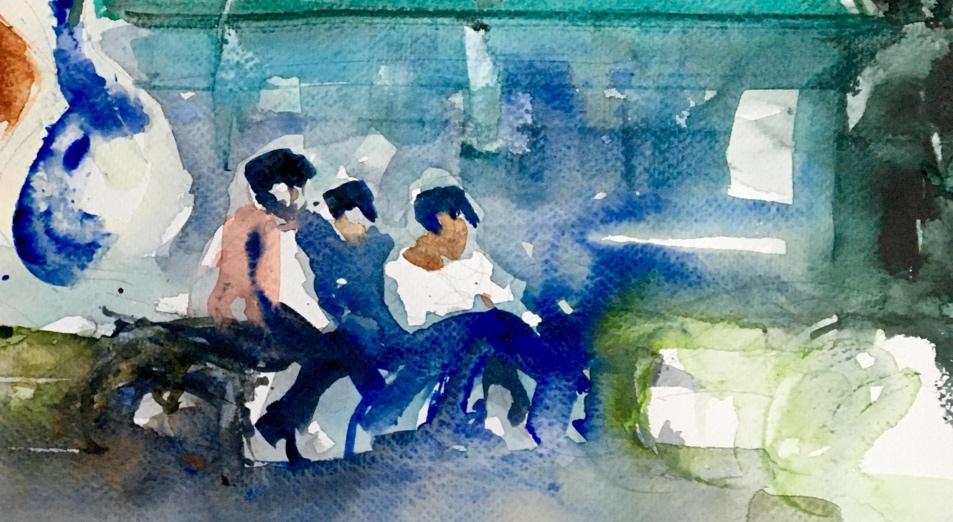
Beyond Urban Sketching
Ethnographic Drawing as a Visual Analytical Method
Abstract: In this article I have chosen a contemporary phenomenon, urban sketching, as an empirical starting point. Through active participation as an urban sketcher through digital publishing, dialogue and interaction, I analyze my analytical process and urban sketching practice. The aim is to examine ethnographic drawing as a visual cultural analytical method. My contribution is based the connection between urban ideals and innovative, creative environments in a local context. An overall knowledge goal is to develop visual methods and perspectives in the borderland between cultural analysis, artistic research, and new academic formats. Sketching and drawing can be compared to written ethnographic notes made during fieldwork or observation. The relationship between drawing and taking notes can be regarded as a dialogue, an ongoing conversation in which the importance of adopting a new vision is more important than the competence to draw.
Keywords: Urban sketching, ethnographic drawing, visual methods, urban transformation, autoethnography
____________________
When in Europe, don’t miss Skurup
Urban sketching is part of a global movement that encourages us to draw what we see in our immediate environment. It´s not about sitting at home and painting by the help of photos, it’s about going out and painting on the spot. As an urban sketcher, you do not beautify what you see, you are true to your motive - of documentation of our time.1
This is how a five-day course in Urban Sketching is described, a course given in a small southern Sweden town in the summer of 2021. The course is aimed at both beginners and experienced artists. According to the course information on the website, you will go through perspectives and different techniques to learn how to draw houses and buildings in a personal style. In addition to houses, vehicles, vegetation, and people will also be in focus. Since it can be “scary” to draw people, one of the ambitions is de-dramatizing such fears.
The interest in depicting and documenting urban life in various ways is a growing field. Photography has become an obvious everyday practice to share on social media, often in combination with some text. Focus on the local urban environment and the self-experience is a recurring theme, and the degree of authenticity claims varies. New interest groups, social movements, and digital communities, that extend far beyond geographical and social boundaries are constantly being created. One of these movements is the global network “Urban Sketchers”. Those in the network are interested in drawing different cities around the world and describe themselves as part of a “worldwide non-profit organization” to promote “drawing and visual storytelling done on site and from observation”.2 When Urban Sketchers calls for "practice drawing on location in the cities, towns and villages”, it can also be about helping a community gain visibility and putting a place on the map.3
From anthropological and sociological perspectives, the city´s diversity and mosaic of different cultures have gained much of methodological attention (Hannerz 1983, Marcus 1986). For the urban ethnographer, the urban fieldwork has primarily been focused on the observation of “people in situ” (Schwanhäußer 2016). The act of “being there” has, since the 1980s, become an important practice for thinking about the city (Jackson 1985). This was also a time when the European industrial cities were transformed into urban experiences, and the service industry called for a new kind of urban landscape infrastructure. Cities and urban environments are today characterized by an ongoing aestheticization where urban culture is shaped based on artistic ambitions. Consultants, marketers, and site developers like Richard Florida (2002) or Charles Landry (2008) have written many manuals on the optimal toolbox for creating creative sites. In the tourism industry and destination development, there is a strong belief in the power and potential of culture and creativity in terms of making a place visible. These ambitions are often shaped in the form of various projects and events linked to specific values.
The empirical focus in this article is the contemporary development of coastal destinations and urban transformation projects. Here is an ongoing dialogue in various forums about who is responsible for developing the urban space and how a "living city" should be designed. Along with visions of a living city, follow visions of what kind of attractions and what kind of environments and atmosphere such a city needs. In order to develop attractive environments, inspiration is increasingly drawn from art, culture, and the creative industries (cf. Reckwitz 2017). Concepts such as “culture-driven innovation” or “culture-driven growth” have had a strong impact when it comes to a specific type of planning and site development process (Evans 2001; Kay Smith 2010; Grodach 2013; Fredriksson 2013).
I have chosen a contemporary phenomenon, such as urban sketching, as an empirical starting point. Through active participation as an urban sketcher through digital publishing, dialogue and interaction, I will analyze my analytical process and urban sketching practice. The aim is to examine ethnographic drawing as a visual cultural analytical method. Here, more research and analyzes of ethnographic drawing, or graphic anthropology, are requested. In ethnology and the humanities, there is a lack of concrete and practical experience of what the method can entail and a lack of a developed methodological and theoretical discussion of process and approach. My contribution is based the connection between urban ideals and innovative, creative environments in a local context. I will use an exploratory and autoethnographic approach, as well as a broader understanding of ethnographic drawing as a visual technique, as a tool for interpretation, communication, and as a way to present research results. An overall knowledge goal is to develop visual methods and perspectives in the borderland between cultural analysis, artistic research, and new academic formats.
In the following, I give a brief literature review and some empirical and autoethnographic reflections about my experiences of visual documentation in the field. When it comes to my own practice, the autoethnographic approach becomes an important part of a wider understanding of how a global movement as urban sketchers approaches different environments, people, situations, and relations. How can sketching and observation-based drawing develop the visual thinking of the ethnographer?
Thinking by the line
The transformation of empirical material into a scientific text is a process that involves various elements of interpretation and representation. Exploring the well-known is one of the recurring fieldwork challenges (Ehn & Löfgren 2016). The art of making oneself alien to places, phenomena, or situations tends to become more difficult the closer we get. Ethnographic drawing and visual thinking can be challenging starting points. By composing and using drawings and paintings in my recent fieldworks I have become more aware of what matters and the importance of thinking along the lines as creative method, representation, statement, and as tool for further interpretation. Sketching and drawing can be compared to written ethnographic notes made during fieldwork or observation. The relationship between drawing and taking notes can be regarded as a dialogue, an ongoing conversation in which the importance of adopting a new vision is more important than the competence to draw.
In contemporary anthropology, ethnographic drawing has become a rare visual practice with straggling roots that give rise to many questions concerning methodology, documentation, and ethics. However, in the constant stream of photos and films, ethnographic drawing can offer other forms of documentation, problematize ingrained culturally-analytical translation techniques, and enable new spaces of interpretation. Within the cultural analytical and anthropological tradition, the thick ethnographic description has long had a specific value as a form of representation (cf. Pink 2004; Clifford & Marcus 1986). Today we see a search for new visual methods and forms for representations in the field of anthropological and humanities research (Kuschnir 2016; Causey 2017). However, there is still a significant research gap in cultural theoretical perspectives and issues. As the ethnologist Billy Ehn (2012) has pointed out, it is not enough for a cultural analyst to just adopt artistic or creative methods. Instead, we should see art "as an alternative form of knowledge production, with other purposes, rules and methods" and actually ask ourselves what it accomplishes.
Drawing, photographing, and writing are forms of representation that have been problematic in different ways (Soukup 2014). During the 1980s, anthropological texts were questioned in a fundamental way, but photography and drawing have also been questioned in terms of analysis, interpretation, and representation. As Michael Taussig (2011) has pointed out, the difference between a drawing and a photograph becomes clear when comparing a photograph of one drawing and a photograph of something else. The photo of the drawing has a different credibility, perhaps because it is a kind of representation of a representation. The photo of the drawing does not appear to be a first-hand representation and therefore loses credibility. The connection between photography and technology makes it appear more objective. Nevertheless, according to Roland Barthes (1981), such a claim is also an inherent problem of photography. A photo is not an objective form of representation but can be interpreted in different ways by the viewer. Often the photograph may serve as an illustration or support for an argument or reasoning. Drawing works here as the opposite of photography; instead of freezing a context or environment on a special occasion, ethnographic drawing becomes a transformative collaboration in dialogue between subject and object, between the artist and the depicted (cf. Ingold 2016).
As photography developed during the latter part of the 19th century, ethnographic drawing became less common in anthropology. At the same time, anthropologists and ethnologists became interested in drawings made by the people and cultures that were the focus of field studies. Such drawings became part of the empirical material and were interpreted as a direct representation of the studied culture (Johansson 2016; Soukup 2014). It is also common to use children's drawings in a more or less psychologizing way. The anthropologists' text-based studies of cultures without texts or literacy reinforced the image of the "primitive" societies. Nor were the oral statements seen as particularly reliable. From such a perspective, "the native drawing" became a wordless, but credible representation of the culture studied, just as photography became a reliable source for documenting the foreign and exotic.
Between fieldwork and observation-based drawing
Drawing can be compared to the field notes that often are created during fieldwork or observation (Piga et al 2021). The relationship between drawing and taking notes can also be regarded as a dialogue, an ongoing conversation (Ramos 2004; Berger 2007; Becker 2007; Taussig 2009; Kuschnir 2011) where the importance of adopting a new vision is more important than the ability to be able to draw. During an ethnographic observation, it is common to experience that nothing special happens. Here, observation-based drawing can help us become more responsive to the seemingly mundane and trivial. The sketchbook functions as a memory object for the ethnographic experience. It creates connections between words and images and, as Taussig puts it, new connections between “inner and outer worlds” (Taussig 2011).
Can ethnographic drawing be a method that facilitates the distance that is needed in doing observations and fieldwork? Even human nature seems to prevent us from being distanced in a well-known environment (cf. Horowitz 2013), and we must somehow "choose" what we see. We often see what we expect to see, and we become more or less blind to the familiar. What we "naturally" see is what is new to us. Ethnographic drawing functions as a way of disrupting our everyday selection process and transforming the familiar into something unknown and exotic. Unlike writing or writing down, drawing requires some form of spatial spatiality. A motif is often placed in a context. An interesting aspect of ethnographic drawing when doing fieldwork or observations is that the researcher also is seen and can be observed by others. Such dramatization is an important part of the cultural analysis tradition.
Another possibility is to use photos taken during fieldwork and observations to translate selected parts into drawings and sketches later. Such a translation process can provide opportunities for new interpretations of an environment, an event, or a phenomenon. Drawing and sketching do not take place in a social or cultural vacuum. The visual transformation from photo to drawing can make us see new things or connections. The photo needs to be simplified, framed, and selected in various ways to make sense visually . How can the dialogue between photography and drawing result in new perspectives and create other research questions (cf. Wadle 2012)?
Into the field
I intuitively tried to use drawn or painted sketches during later empirical studies to interpret and analyze my material. Such translation processes, mainly from a number of quickly taken photographs in the field, have made me aware and curious about the possibilities and challenges of the method (Fredriksson 2018; Fredriksson 2019; Fredriksson 2021). As a watercolorist, I have gained experience drawing people, contexts, and environments. The drawing practice is usually joyful and relaxing. I received my artistic education during a few intensive years during the early 1980s. In my academic activities, I have mainly devoted myself to producing scientific texts. However, in recent years the two worlds have crossed each other more often, and it happens that I combine text with illustrations or make book covers. Sometimes I take courses to immerse myself and develop a specific theme in watercolor or other techniques. Such learning processes develop my writing in different ways.
The description of the planned summer course in urban sketching quoted in the introduction differs from the courses I have come in contact with before. The connection to a global movement is central to the course description. It also seems to be less about learning a particular technique and more about learning a particular approach:
The purpose of the course is to get you started as urban sketchers and send you out into the world! You will discover a rewarding hobby that can be practiced wherever you are and gives you a chance to make future contacts with urban sketchers from around the world. / --- / As a course participant, you are expected to come out with me and draw! I will show you that it is perfectly OK with a curious audience and we always show each other what we have drawn to get feedback and encouragement.4
Being a "participant in the world" as a course participant sets specific requirements and creates expectations. At the same time, it is emphasized in the course description that everyone is welcome and those individual expressions are essential. Social interaction involves, among other things, drawing in front of an audience and sharing their results with other course participants. In the following, instead of taking the summer course, I will explore urban sketching in relation to my ongoing fieldwork in a small-scale environment that is facing extensive urban transformation.
“Kuststad 2025” is an urban development project in Trelleborg in southern Sweden, which involves major investments in business and infrastructure. 4,000 new homes will be produced near the sea, and more than five kilometers of quayside will be available for residents and visitors. The “city of palm trees” will, in the next few years, be transformed into “Sjöstaden, the city by the sea”. The municipality of Trelleborg wants to take a holistic approach so that the city will “regain contact with the sea”. The border between the port and city will be moved, and new districts will emerge. It will be a mix of housing, premises for business, and attractive meeting places:
Trelleborg is the city of palm trees! You can stroll along Sweden’s only palm-lined avenue, visit a genuine Viking fort and feed peacocks in the City Park. The shopping on offer is varied, with everything from market stalls to Valen Gallerian, hosting 30 or so different stores. The city is known for its public art and beautiful gardens. For example, you will find one of Europe’s most northerly avenues of Ginkgo Biloba trees! Culture enthusiasts can enjoy a varied selection of museums, but most worthy of a visit is the recreated Viking fortress Trelleborgen.5“The new districts will be full of life”, says one of the planners on the municipality’s website, and it is also possible to take part in a film posted on Youtube with a guided tour of the coming city transformation. The digital future visions present new places for meetings, socializing, and play, focusing on a circular economy. Traffic will be diverted away from the city center, and residents and visitors will get closer to the water as the city gets ready to once again “meet the sea”.
The historical perspective is an important element in putting Trelleborg back on the map. When the ferry route between Trelleborg and Sassnitz was inaugurated in the early 20th century, the city became a transit arena for global events and a gateway to the wider world. Back then, “the people of Trelleborg could go straight out to the harbor and look at the arriving boats”, and now the journey to become an “attractive coastal city” has begun.6
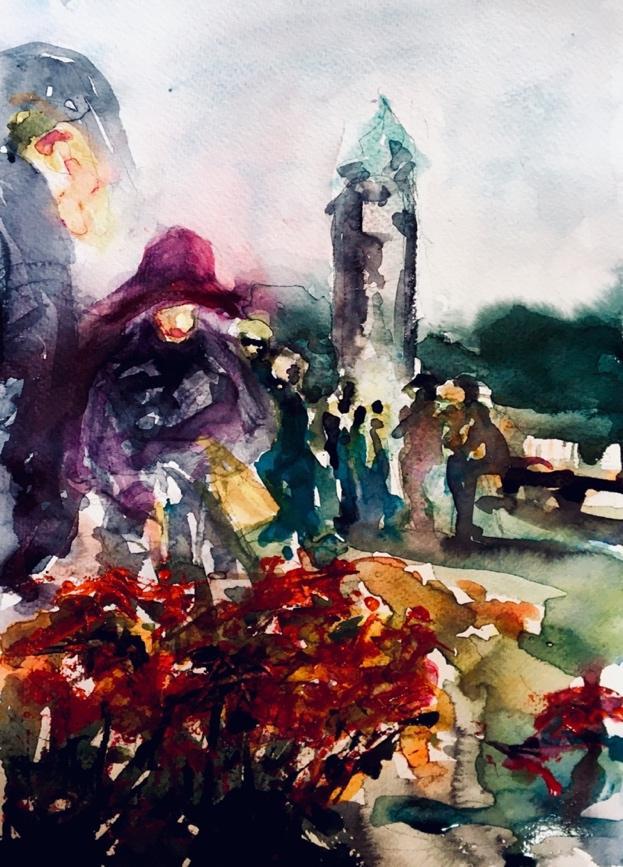 With the help of a pencil and watercolor, I approach the book cover.
The cover photo caught my attention as the book lay on the shelf in a
second-hand shop a few years ago. Maybe it was the seventies motif with
flower sales and people in the square in front of the water tower that
appealed to me. Or the well-dressed woman in a suit and purple hat who
so definitely points to the bouquet of orange-red asters she has
chosen.
With the help of a pencil and watercolor, I approach the book cover.
The cover photo caught my attention as the book lay on the shelf in a
second-hand shop a few years ago. Maybe it was the seventies motif with
flower sales and people in the square in front of the water tower that
appealed to me. Or the well-dressed woman in a suit and purple hat who
so definitely points to the bouquet of orange-red asters she has
chosen.
At the square, some people happened to be caught in a photograph in a small town in southern Sweden in the mid-1970s. On the inside of the book cover, it says that the book was printed in 1977, information that makes me assume that the photo was taken a few, or some years, earlier. I focus the image while I sketch lightly with the pencil. The woman with the violet hat. The face that is shaded, the light that falls on the nose and chin. The body and the suit become lines and cylinders, the belt that breaks the direction of movement, and the bag that rests on the left arm. Unlike the suit and hat, the bag feels more modern, a really big city bag. Who is she, the woman in the purple hat? 7
Maybe she had come by bus to town. The train station, which was closed down in the 1940s, was still closed. Before that, the railway between Trelleborg and Lund took the road over Minnesberg, Alstad, and other places that I had heard about a long time ago but then forgot. Minnesberg had a brick factory, and in the small community, all the houses were still made of brick. Brick walls, brick pattern, brick pond. But the mill is quiet and still in the sun when we take the car there on a Sunday in May.
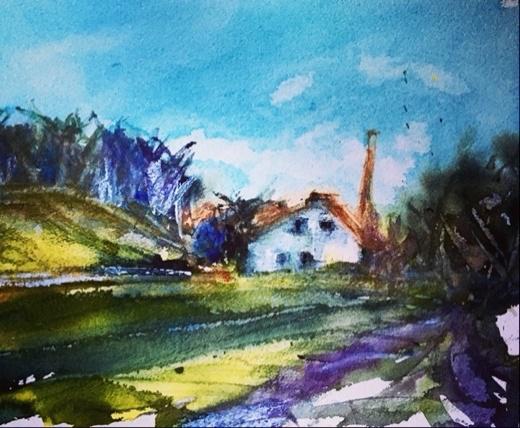
The chimney still sticks out, marking itself in the landscape: few kilometers away, another chimney, another brick factory. No church towers can be seen here, a place that God forgot?
We follow te road in the footsteps of the old railway. More than 60 years ago, it was closed down. But the sun is still shining on the station building. The vanilla-yellow plaster over the brick shines like a magic window in the landscape. I can’t manage to catch it, although I try several times. I cannot open the window that remains closed.
I fail and switch to other pens, capture the perspective in 60 seconds, and mix watercolor with black ink. But my sketch lacks direction and content. I don’t t know what I am trying to catch or how to open that window which, in different ways, seems to be about a place I have never visited.
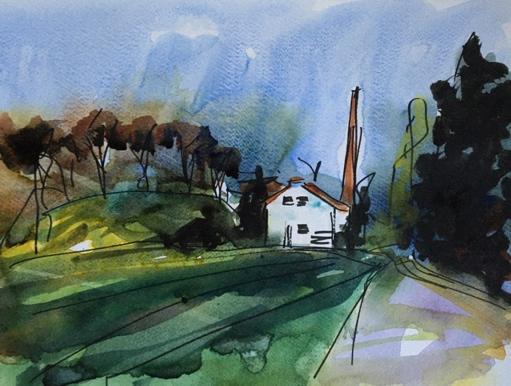 When leaving, we pass by a resting place with a view and make a stop.
This is the old road between Lund and Trelleborg. The table with
benches on each side is cast in cement, ingrown with moss, and many
decades of patina. It seems to have stood there since the railway was
closed and private motoring took off. It is a fantastic place in the
sun and wind; we eat our packed lunch at the table and look out over
the landscape.
When leaving, we pass by a resting place with a view and make a stop.
This is the old road between Lund and Trelleborg. The table with
benches on each side is cast in cement, ingrown with moss, and many
decades of patina. It seems to have stood there since the railway was
closed and private motoring took off. It is a fantastic place in the
sun and wind; we eat our packed lunch at the table and look out over
the landscape.
Here I may have sat before, right at this table .8
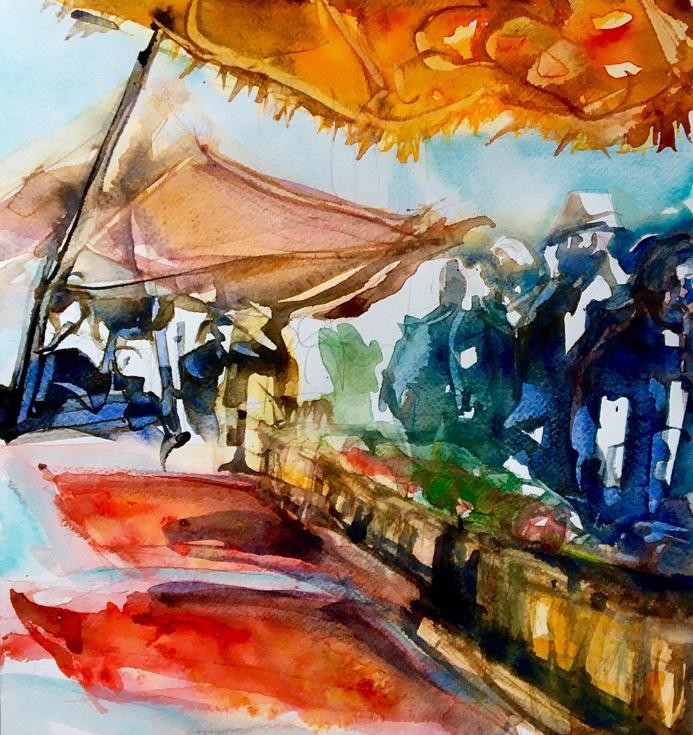 Back to the marketplace in 1977. This time I get closer to the picture,
sketch myself into it, and recognition arises. It is the photo on the
back of the book that is in focus, probably taken the same day as the
woman in the purple hat chose asters at the marketplace. In the shadow
of an orange parasol, apples in wooden boxes are offered for sale, and
customers flock around the stand this autumn day more than forty years
ago.
Back to the marketplace in 1977. This time I get closer to the picture,
sketch myself into it, and recognition arises. It is the photo on the
back of the book that is in focus, probably taken the same day as the
woman in the purple hat chose asters at the marketplace. In the shadow
of an orange parasol, apples in wooden boxes are offered for sale, and
customers flock around the stand this autumn day more than forty years
ago.
In the foreground are red berries that look like lingonberries, it is a sunny day in the autumn in southern Sweden, and Trelleborg is a city with big plans even though the railway station has been closed since the 1940s.
I sketch and let the watercolor paint spread over a light blue sky and orange fabric parasol. The typical seventies flowers in yellow and brown, with a short fringe that borders the parasol. I can almost feel the rough fabric when I drip paint here and there, marking the fringe that stands out against the sunlight. It looks like it's a cold day; men wear hats or caps and some scarves.
I paint quickly and create lines on the wet paper before the paint dries. There are a few minutes when the window is open, before the moment is over. The process is focused, but also relaxing because the action prevents too many thoughts from taking place. Thinking by the line. Yet the reflection is always there. The translation between images creates a mood, a certain feeling. Is this what I'm looking for? What am I trying to capture? 9
*
When I publish the picture on Instagram and tag it with keywords such as #streetlife, #urbanillustration, #watercolorpeople, and of course #urbansketching, I get some comments that say things like “Wow!” or “So dynamic! Love it!”. But I also get different interpretations of the red berries in the foreground. Here, new contexts are created through the viewer's eyes where one sees red carpets for sale at a Central European bazaar, while another sees a demonstration with fluttering red flags and adds, “like first May if everything was normal !!!”
The comments make me start to look at the picture in a different way. The red berries, which I did not attach much importance to more than trying to reproduce the intense color, open up for other interpretations. The red fields in the foreground lead to different images depending on the association. 10
*
I have started to think about whether my interpretation of the image should really be published together with this text. I have perceived the cover image as an object to depict, interpret, and transfer to create reflection. But when the new image is ready, questions about copyright will be raised. Depicting a photo or other work of art is permitted as long as the new work is not sold, exhibited, or otherwise distributed. What does it mean to multiply the image on the cover of the book? Should I contact the photographer who took the picture sometime during the 1970s?
Urban sketching based on historical material seems problematic in terms of copyright if the sketches are spread in different ways. On the other hand, the process is less problematic as long as it takes place in the private sphere. When I use information material that the city has posted on youtube or its website, there are no problems in quoting and stating the source, but the depiction is more complicated. Can I solve this difficulty? Is it a problem at all? I’m thinking about focusing on the book as an object instead of an image. The book as a material object lying on my table. Is this a context that changes the regulations? 11
Breaking the rules?
While I am working on this text, Urban Sketchers is announcing a contest on their website. There is an opportunity to become an observer of an urban environment in the autumn of 2021. I quickly write an application and attache some watercolors with Trelleborg motifs. Information on who has been selected by local observers will be presented during the summer. The application process leads to new reflections on what I am actually doing. What happens if I am selected as a local observer? How do I handle my dual roles as a researcher and cultural analyst while participating in the production of the visual practice I study? At the same time, I am already involved. On my Instagram account, I share several watercolors and tag them with keywords like #urbansketching, #urbanillustration, and other versions of the theme.
The application process also provides in-depth insight into the challenges that such a commitment requires. Above all, the first and perhaps most important point in the organization's manifesto, “We draw on location, indoors or out, capturing what we see from direct observation”, will be difficult to fulfill.12
I do not draw on-site, and I do not always document the present. In addition, my activities as an urban sketcher are quite lonely and rarely in dialogue with others. The feedback given in digital forums is sparse and is mostly about likes or a heart given here and there. Still, it is something that drives me to constantly draw and paint myself into the research object. As if the translation and transformation itself are what matters. The method is still a rather new experience, and the visual activity is often governed by a kind of flow, a desire to get behind what I have just experienced. Or maybe see it another way. In the immediate experience, I can get really close to what I am investigating.
Watercolor is a complicated and difficult technique. The water and the color often behave in unexpected ways. The achieved effects are mostly the result of processes beyond your own control. Maybe it is that kind of challenge that contributes to the benefits of the method. The unexpected result requires a flexible approach, a kind of adjustment when the whole project takes a different direction. Not always being in control of the process can be liberating. If that experience also includes the release of the cultural analytical ability, I am prepared to challenge the exploration. In the following, I continue to explore an art event that took place in Trelleborg in 2021.
“Konstkiosk” as a social space
Konstkiosk imagines a society where the public space exists without private infiltration which undermines its importance of being a social space.13
The densification of cities often means that public space is shrinking and common meeting places are becoming fewer and fewer. In connection with the transformation of the city of Trelleborg, the project “Konstkiosk” (Art Kiosk) was established, a project that has also generated similar exhibitions in other municipalities in southern Sweden.
When the curators of the exhibition are interviewed by the local newspaper, they say that the purpose is to draw attention to "the kiosk as an important place for dialogue”.14 Protecting the kiosk as a meeting place is a recurring ambition for artists and architects. The curators Christel Lundberg and Peter Dacke further explain that they managed to save an old flower kiosk in Malmö a few years ago, and “since then they have been the kiosk's patrons”.15 The project is funded by Region Skåne, the Swedish Arts Council, and Trelleborg Museum.
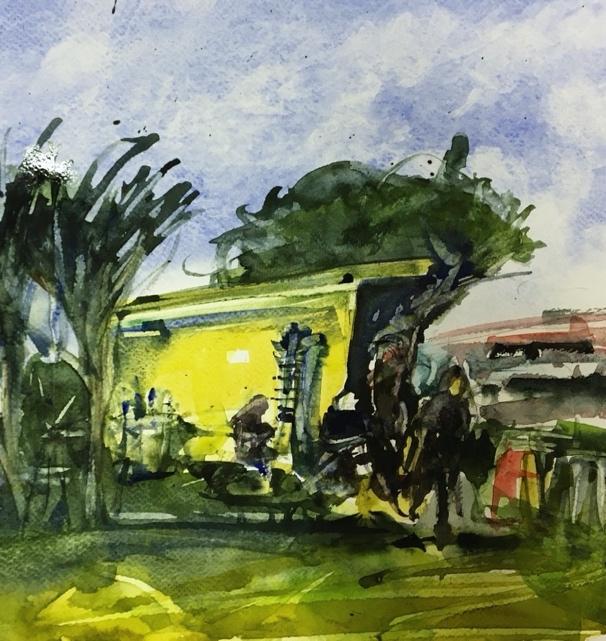 A yellow kiosk has been built at the truck station near the entrance to
the port. It's May, and the weather is beautiful, warm enough. Not many
cars can be seen in the parking lot, but the exhibition has just begun.
The characteristic shape of a kiosk is recognizable in the distance.
The shape is square and modernist, but the color is wrong. I remember
that kind of kiosk as murky green. Almost invisible, they blended into
the urban landscape.
A yellow kiosk has been built at the truck station near the entrance to
the port. It's May, and the weather is beautiful, warm enough. Not many
cars can be seen in the parking lot, but the exhibition has just begun.
The characteristic shape of a kiosk is recognizable in the distance.
The shape is square and modernist, but the color is wrong. I remember
that kind of kiosk as murky green. Almost invisible, they blended into
the urban landscape.
As we get closer, it becomes obvious that the yellow kiosk is form without content. The kiosk is closed, and everything takes place outside. Here you can buy a few things: a small exhibition catalog and postcards of the works of art that sit on lamp posts along the coastal road. Coffee and cakes are also available. The kiosk's closed door consists of a screen where movies are displayed.
In the conversation that takes place between some of the visitors and the exhibition group, it becomes clear that the postcards attract great attention. General Motors’ previous activities in the area seem to evoke memories and interest for several of the men studying the postcards. The black and white images are mixed with neon colors in green, orange, turquoise, purple or pink. As waxed by contemporary aesthetics, the photographs invite reinterpretation of a past service industry and hard work life.
“But it shouldn’t be nostalgia”, says one of the exhibitors.
The same pictures on the postcards are set up as works of art on the lamp posts along the road along the former industrial area. Here is also a poetic story about the Oxels that line the road. The illustrations by Catherine Dee want to convey the trees’ relationship to the place from an eco-centric approach:
I imagined how the Oxels have watched over industry
workers and ships passing and how they sing lullabies each season in
milky blossom to bees and Trelleborg’s infants since they were planted
half a century ago. I dreamt about how with leaves they have heard in
constance every human-and-sea-mood.
16
After the art walk, we continue along the coastline in the opposite direction. Suddenly I find myself in a place I don’t recognize. Windowless gables form a zigzagging silhouette against the water. A high net fence surrounds the buildings, and the beach strip is lined with boulders and cement formations. Despite the fact that a couple of benches are set up here and there along the gravel path, the place doesn’t seem intended for strolled visitors. After the row of windowless buildings, trucks with their noses pressed against the net fence appear. Side by side, they are waiting for the next ferry, or maybe they have just arrived. The laundry is hanging in the sun between the shiny trucks. Some of the drivers take the opportunity to have a coffee together, but not many of them are visible. Yet we feel observed as we pass the endless line of seemingly empty vehicles. The high fence indicates that this is a place for logistics that should be kept separate from visitors.
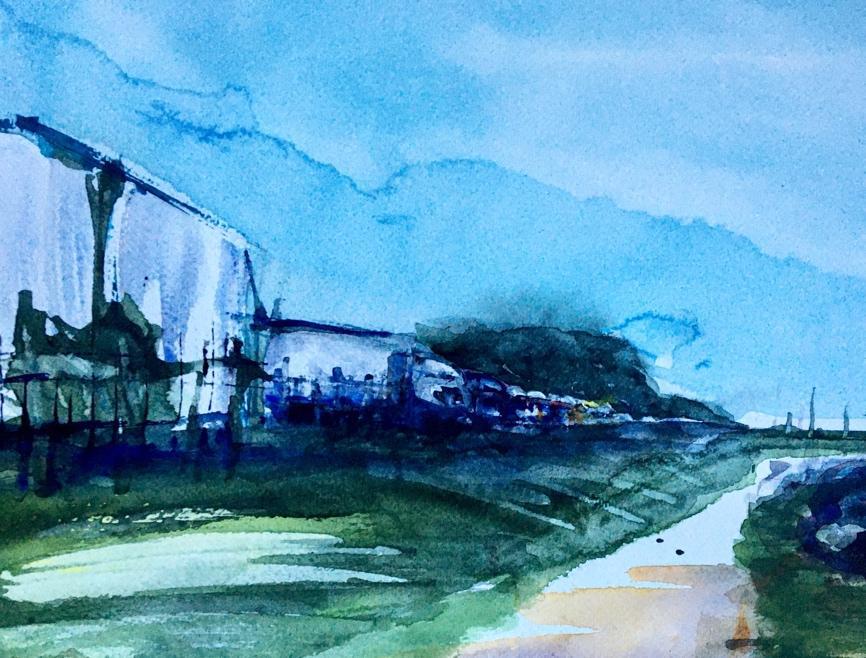
After the closed logistics area, the small gravel road ends, and a port area opens up behind a new fence. It is not allowed for us to continue, but a small opening has been made towards a lookout height. We follow the path, and soon we see far beyond trucks and fences. At the top of the hill, the whole city and the port area suddenly appear. The place doesn’t seem well visited, but binoculars and some signs indicate the distance to other destinations in Europe, telling us that we have arrived at a hidden tourist destination. Far away, we see how new trucks arrive from the ferry that just entered the port.17
In dialogue with the event
Within coastal destination development, the port often has a specific function when staging the local cultural heritage (Fredriksson & Larsson 2013). The harbor becomes a significant metaphor around which the cultural heritage is directed, and through various events, contemporary contexts are created around places with a changed function. This is partly a result of the increasing competition between cities and regions. It's about being on the map of attractive places to live and visit; it's about creating growth and developing creative meeting places. Here, cultural themes are linked to the local or regional context, while unexpected historical references are taken from a diffuse past.
Marketing of cities and places balances different fields of knowledge. In order to develop successful planning strategies, inspiration is often drawn from creative industries that have a more or less critical approach to how places are produced socially and culturally. On the other hand, cultural studies strongly tend to link qualitative methods such as ethnography and cultural mapping to ongoing urban development. This knowledge has been transformed into a specific practice in community planning with a focus on place development and sustainability. The process of initiating and organizing urban transformations involves various elements of discernment, thematization, and choices. Confidence in the potential of culture and creativity when it comes to city planning has been criticized for paving the way for cultural structures that society finds desirable (Zukin 2011). Culture becomes a magical shortcut and universal solution to win the national or regional competition between places and cities. Here, the changing conditions for cities when it comes to aesthetics, history, and authenticity, becomes visible in the context of a global social movement as Urban Sketchers. The desire to document the ongoing urban life becomes clear in the demands for authenticity and immediacy that the movement advocates.
What did I gain from the experience of using ethnographic drawing as a visual cultural analytical method? Did I explore the field differently from ordinary fieldwork? When looking at the drawings and the watercolors used in this text, I find an overarching theme focusing on the explorative search for possible entrances to the field. I try to get close to the urban space by drawing and painting myself in an area of ambience, first through historical documentation concerning the turning point when Trelleborg was still a dynamic hub in the southern part of Sweden. Then through an excursion in the forgotten landscape outside the city where abandoned activities and rest areas bring personal memories to life. Finally, by following an art installation that takes place in the coastal landscape and the deserted lanes along the shores of the Baltic Sea.
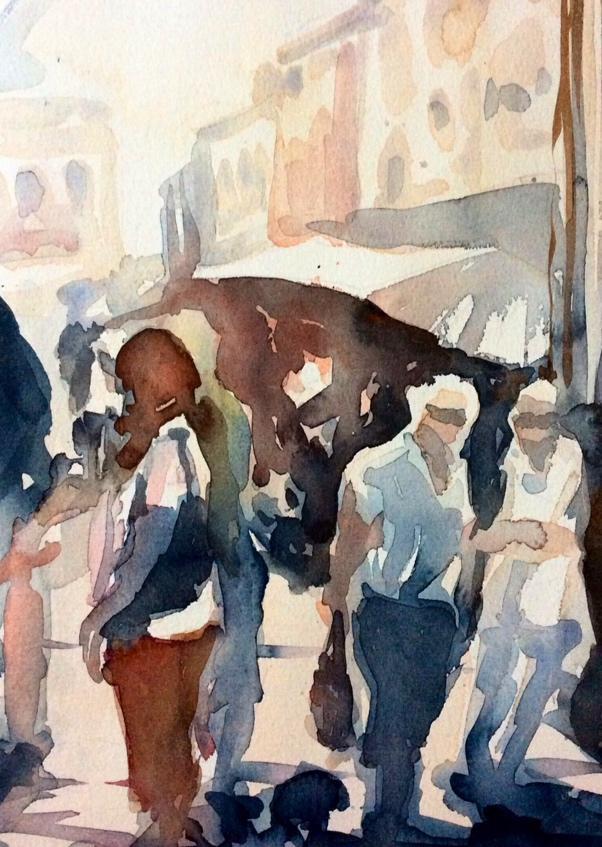
While transforming the photo of the kiosk into a watercolor, the specific aesthetics of the kiosk became obvious. The painting practice worked as the opposite of taking a photograph of freezing the moment, it became a transformative collaboration in dialogue with the event. Moreover, even if former service facilities in the urban landscape convert into history and cultural heritage through temporary artistic installations, it still seems like small shops and services like the kiosk creates accessibility and unexpected meetings.
The contemporary interest in coastal cultural heritage is reflected in specific settings loaded with norms and values. The poetic story about the kiosk and the local trees watching over industry workers while ships were passing by is also a story about the making of cultural heritage, based on a process where specific themes were selected, historized, and given a new meaning. When it comes to place marketing, the focus is often on dynamics, excitement, movement, and diversity. The notion of mobility, in combination with diversity, can also be linked to the social and cultural mobility that is an important theme in the field of social sustainability in community planning: a place or a city must be accessible to all. Here, conflicts of interest often arise between different actors and between different ideas about accessibility and diversity.
Re-establishing contact between the city and the water is an important part of the future vision in Trelleborg. Nevertheless, radical changes such as moving a port or redirecting traffic also mean major changes in people's everyday lives. Accessibility might create other barriers. The establishing processes take time, and there is a strong belief in the transformative abilities of art and culture. Here, culture and creativity are described as necessary tools to enable innovation, growth, and tolerance. Such manuals also include advice on what kind of people and environments a creative city needs to be successful, as well as how to go about creating the conditions for the mixed, tolerant, and ever-growing city.
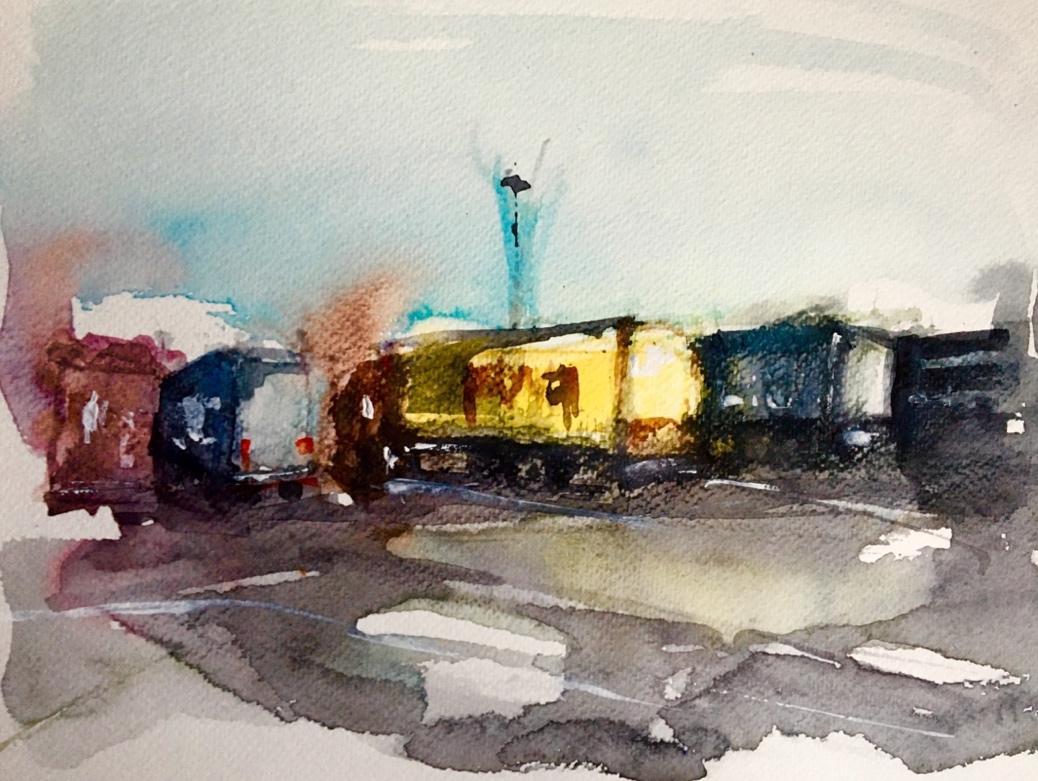
Notes
1 https://sommar.skurupsfolkhogskola.se/Kursutbud-2021-Urban-Sketching , translated from Swedish by the author. [ Return to the article ]
2 www.urbansketchers.org [ Return to the article ]
3 http://www.urbansketchers.org/p/usk-members.html [ Return to the article ]
4 https://sommar.skurupsfolkhogskola.se/Kursutbud-2021-Urban-Sketching , translated by the author. [ Return to the article ]
5https://www.visittrelleborg.se/en/ [ Return to the article ]
6Ibid. [ Return to the article ]
7 Field notes, April 30th, 2021 [ Return to the article ]
8Field notes, Minnesberg May 8th, 2021 [ Return to the article ]
9Field notes, May 14th, 2021 [ Return to the article ]
10Field notes, May 15th, 2021 [ Return to the article ]
11Field notes, May 20th, 2021 [ Return to the article ]
12http://www.urbansketchers.org/p/our-manifesto.html [ Return to the article ]
13http://konstkiosk.se/konstkiosk/vision/ [ Return to the article ]
14https://www.trelleborgsallehanda.se/trelleborg/en-konstkiosk-har-tagit-plats-i-trelleborg-df82109c/ [ Return to the article ]
15Ibid. [ Return to the article ]
16Exhibition catalog [ Return to the article ]
17Field notes, May 22th 2021 [ Return to the article ]
Works Cited
Becker, Howard S. 2007. ”Charts: thinking with drawings.” Telling About Society. Chicago: Chicago University Press.
Berger, John 2007. Berger on Drawing. Jim Savage (ed.) Aghabullogue: Occasional Press.
Causey, Andrew. 2017. Drawn to See: Drawing as an Ethnographic Method. Toronto Press.
Clifford, James and Marcus, Georg. 1986. Writing Culture. The Poetics and Politics of Ethnography. Berkeley: University of California Press.
Ehn, Billy. 2012. ”Mellan konst och kulturanalys. Om alternativ kunskapsproduktion.” RIG: Kulturhistorisk tidskrift, nr 1, s. 1-13.
Ehn, Billy and Löfgren, Orvar. 2016. “Doing an Ethnography of ‘Non-Events’ “. In: Schwanhäußer, A (ed) Sensing the City. A Companion to Urban Anthropology. Basel: Birkhauser.
Evans, Graeme. 2001. Cultural Planning. An Urban Renaissance? London: Routledge.
Florida, Richard. 2002. The Rise of the Creative Class. New York: Basic Books.
Fredriksson, Cecilia and Larson, Mia (eds). 2013). Framtidskuster. Hållbar utveckling i kustsamhällen, Göteborg: Makadam.
Fredriksson, Cecilia. 2013. ”När kust blir konst. Om kultur och kreativitet som hållbarhetsgeneratorer i ett stadsförnyelseprojekt.” In: Fredriksson, C and Larson, M (eds), Framtidskuster. Hållbar utveckling i kustsamhällen, Göteborg: Makadam.
Fredriksson, Cecilia. 2018. ”What I didn’t see. On ethnographic illustrations, interpretation and text.” Conference paper presented at the 34th Nordic Ethnology and Folklore Conference in Uppsala, 12-15 juni 2018, Sweden.
Fredriksson, Cecilia. 2019. ”Thinking along the lines. On ethnographic drawing, interpretation and text.” Conference paper SIEF 2019 14th Congress Santiago de Compostela, Spain 14-17 April 2019 Track Changes: Reflecting on a Transforming World.
Fredriksson, Cecilia. 2021. ”På spaning efter tången.” In ETN: H20, Etnologisk skriftserie, Etnologiska avdelningen, Institutionen för kulturvetenskaper, Lund University.
Grodach, Carl. 2013. “Cultural Economy Planning in Creative Cities: Discourse and Practice” In: International Journal of Urban and Regional Research, 37, 1747–65.
Hannerz, Ulf. 1983. Exploring the City: Inquiries toward Urban Anthropology. New York, NY: Columbia University Press.
Horowitz, Alexandra. 2013. On Looking - Eleven walks with expert eyes. New York: Scribner.
Ingold, Tom. 2007. Lines: A Brief History. London: Routledge.
Ingold, Tom. 2013. Making - Anthropology, archaeology, art and architecture. London: Routledge.
Jackson, Peter.1985/2016. ”Urban Ethnography”, in Schwanhäußer, A (ed): Sensing the City. A Companion to Urban Anthropology. Basel: Birkhauser.
Johansson, David. 2016. ”Vad innebär tecknande för den antropologiska observationsprocessen idag?” C-uppsats i kulturantropologi, Institutionen för kulturantropologi och etnologi Uppsala Universitet.
Kay Smith, Melanie. 2010. Cultural Planning for Urban Regeneration. A Thirdspace Approach. Saarbrucken: LAP Lambert.
Kuschnir, Karina. 2011. ”Drawing the city - a proposal for an ethnographic study in Rio de Janeiro” in Vibrant - Virtual Brazilian Anthropology, 8(2): 609-642.
Kuschnir, Karina. 2016. ”Ethnographic drawing: eleven benefits of using a sketchbook for fieldwork.” In Visual Etnography, vol 5, n 1.
Landry, Charles. 2008. The Creative City. A Toolkit for Urban Innovators. London: Earthscan Ltd.
Marcus, George E. 1986. “Ethnography in/of the World System: The Emergence of Multi-Sited Ethnography.” Annual Review of Anthropology, 24: 95–117.
Piga, Barbara E A et al (eds). 2021. Experiental Walks for Urban Design. Springer Tracts in Civil Engineering.
Pink, Sarah. 2004.” Introduction: situating visual research.” In: S. Pink, L. Kürti & A. I. Afonso (eds). Working Images: Visual Research and Representation in Ethnography. London/New York: Routledge. Pp. 1-12.
Ramos, Manuel J. 2004.” Drawing the lines: the limitations of intercultural ekphrasis.” In: S. Pink, L. Kürti & A. I. Afonso (eds). Working Images: Visual Research and Representation in Ethnography. London/New York: Routledge. Pp. 147-161.
Reckwitz, Andreas. 2017. The Invention of Creativity. Modern Society and the Culture of the New . Cambridge and Malden: Polity Press.
Schwanhäußer, Anja. 2016. Sensing the City. A Companion to Urban Anthropology. Basel: Birkhauser.
Soukup, Martin. 2014. ”Photography and drawing in anthropolgy” in Slovak Ethnology (Discussion 4:62).
Taussig, Michael. 2009. ”What do drawings want?” In Culture, Theory and Critique 50(2): 263-274.
Taussig, Michael. 2011. I swear I saw this: Drawings in Fieldwork Notebooks, Namely My Own. Chicago: University of Chicago Press.
Wadle, Hanna. 2012. Anthropology goes Comics. Comics Forum Blog. comicsforum.org/2012/02/03/ anthropology-goes-comics-by-hannah-wadle
Zukin, Sharon. 2011. Naken stad. Autentiska urbana platsers liv och förfall. Göteborg: Daidalos.